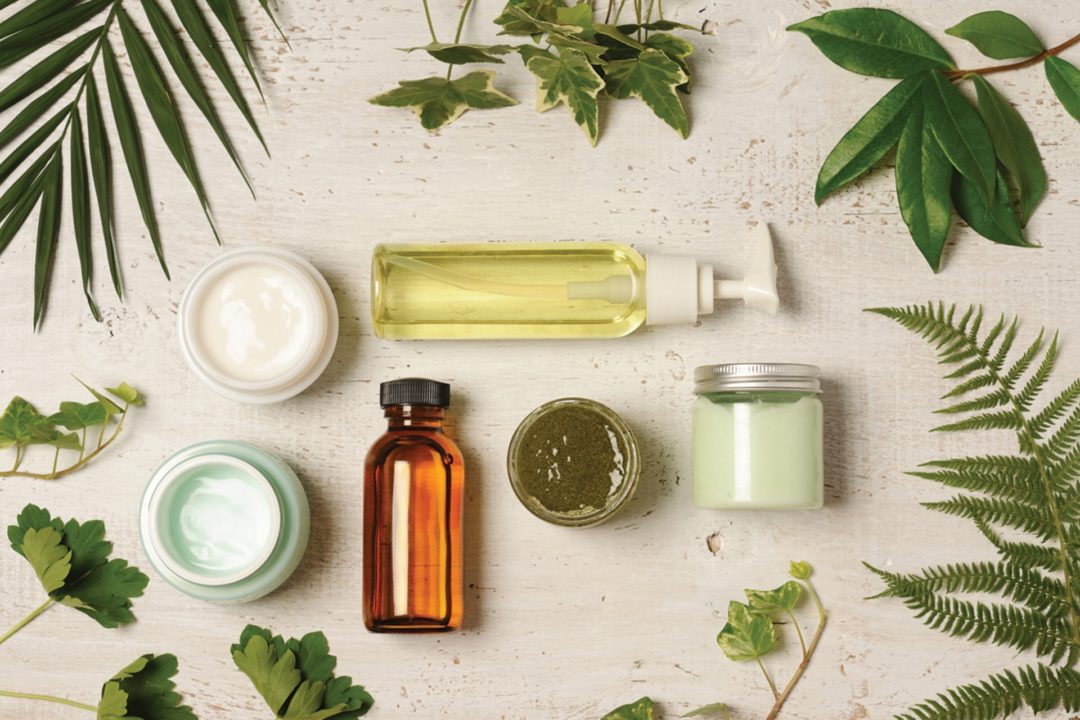The most buzzed-about stars in HABA right now, without a doubt, are cannabidiol (CBD) and hemp. Myra Mesko, founder and CEO of Botanical Rush, Boulder, CO, was “thrilled” when the 2018 Farm Bill passed: “Up until now, many retailers were terrified of selling hemp cannabinoid skincare and supplements due to the legal status of selling cannabinoid-rich formulas.” Now that there’s the chance of being sold on the market, more companies will begin using cannabinoids, and Mesko couldn’t be happier. “The beauty industry hasn’t seen such an exciting ingredient to formulate with since AHA’s and peptides came on the market three decades ago. Cannabinoids are a game-changer!” They’ve got it all, she says: anti-inflammatory effects, oil-balancing properties, anti-aging results; “Cannabinoids from industrial hemp are the newest rage in harmonizing skincare, which will surely make a positive mark on this industry.”
Of course, as with any ingredient, there will be those trying to capitalize on its popularity without putting in the effort to use it properly. Mesko says retailers should watch out for companies using only CBD: “There are over 100 cannabinoids (discovered for now) which I believe all work together to provide ultimate healing and pain relief. There are companies that will spike their formulas with a CBD distillate. This is not the same as a full-spectrum extract as it is found in nature.” She references a study done by researchers at the University of Colorado Anschutz Medical Campus that summarized the literature on the topic, and found that full-spectrum cannabinoid creams eliminated severe itching and dry skin thanks to their anti-inflammatory properties (1).
Botanical Rush makes the most of these properties—the line is based on full-spectrum hemp, except their facial cleanser and toner. Why? “I didn’t see the point of making cleansers with this powerful extract, since it simply gets washed down the drain when rinsing your face,” Mesko says. “Mists also don’t make sense, since a mist is by nature water-soluble and the full-spectrum extract is oil-soluble.” So here’s some more things to watch for, according to Mesko: If a company is selling a water-based product containing full-spectrum hemp extract, look for the emulsifier. Instead of focusing on CBD in facial cleanser, she suggests, focus on serums or oils, where the cannabinoids are concentrated and fully absorbed into the skin for maximum benefits.
Andalou Naturals, too, has a hemp-based product line: Their CannaCell makes use of hemp cell culture extract and hemp seed oil. This line isn’t cannabinoid-based in any way—cannabinoids don’t exist in hemp seed oil or in hemp stem cells (2). Hemp does, however, deliver proteins, nutrients, minerals, vitamins, omegas, and antibacterial properties, making it a powerful ingredient in its own right (2). And the CannaCell line encompasses an entire skincare regimen, which includes cleanser, toner, masks, scrubs, moisturizers, sunscreens—as well as a whole hair-care regimen, too.
Selling CBD: Beauty and beyond
Cannabinoids aren’t just the darling of the beauty world. Gene Bruno, MS, MHS, is professor of nutraceutical science for Huntington University of Health Sciences and serves a senior director of product innovation for Twinlab Consolidation Corp. He contends that CBD is arguably the single hottest dietary supplement ingredient in the natural products industry. “Along with its popularity,” he says, “are a great many questions. For example, according to the FDA, is it even a dietary supplement ingredient, and is it lawful to sell it as a dietary supplement? Is CBD isolate effective, or does it need to be full-spectrum phytocannabinoids? What’s the minimum dosage level that’s considered to be effective? Clearly, there is a great deal of confusion about CBD.” Bruno is helping WholeFoods clear up the confusion in a web exclusive, here.SKIN
Skincare is arguably the most complex HABA category in terms of serving an individual’s needs. Tailoring a HABA regimen to a person’s skin type is the key to helping them look (and feel) their best. And some of it can be counterintuitive.Oily skin doesn’t need to be dried out—it needs moisture: When skin is under-moisturized, it produces excess oil, which can be a problem for those who are prone to acne. As the experts at Reviva Labs note on the company’s website, most people try to dry their skin out in order to get rid of acne, but intense drying removes too much oil and over-stimulates the sebaceous (oil) glands, which in turn can clog pores and exasperate blemishes (3). Reviva’s answer is Glycolic Acid: the cleanser is a mild exfoliant; the toner helps balance pH; and the crème texturizes. Something to keep in mind: Reviva notes that it is possible for skin to get used to 5% Glycolic Crème—customers should start there, and move up to 10% when their skin stops responding to it.
Sensitive skin, too, requires special care. Georgiana Rowley, brand manager for ANNEMARIE BÖRLIND, Ghent, NY, points out that some sensitive skin products that act to “protect” the skin are actually “creating an impenetrable barrier that blocks all agents, bad or beneficial, from entering the skin. That is hardly an ideal long-term solution.” She says Börlind’s ZZ Sensitive Series is different in that it works to address the cause of the sensitivity: pH. “Normal skin is slightly acidic, allowing it to combat bad bacteria and negative environmental irritants. Sensitive skin tends to have a high pH level, compromising its own ability to act as a protective barrier, becoming less resilient and prone to irritations, infections, and chronic conditions.” The Sensitive Series uses golden orchid and pre- and probiotics. “This combination normalizes the skin’s pH levels and promotes the growth of good bacteria. Once the skin reaches normal values, it can be treated with moisturizing, regenerative active ingredients that can penetrate deep into the skin and replenish much needed moisture and nutrients.”
Combination skin might be the trickiest. “Combination skin is always challenging to treat because most formulations focus only on controlling sebum production, without addressing the dry areas on the cheeks and side of the face,” Rowley contends. “The drier these areas, the oilier the T-zone becomes to overcompensate.” To help with this, Börlind’s Combination Skin Series makes use of north Atlantic coast brown algae harvested on the coast of Brittany. As Daniela Lindner, a member of the management board for ANNEMARIE BÖRLIND, explains, the company only uses algae that have high concentrations of minerals and vitamins—A, B, C, D, E, and K (4). “They contain everything you could wish for,” she says, “in a highly concentrated form.” Rowley agrees: “These extracts both retain moisture and regulate sebum production, firm skin, and combat free radicals and premature aging.” This is, it’s worth noting, very specifically a form of knotted wrack, of the Ascophyllum family, harvested sustainably from a specific location, thoroughly washed, and extracted (4). You can reassure your customers that no, it’s not the same as taking a dip in a particularly germy pool.
Men’s skincare can be different, too—Rowley says men’s skincare products tend to focus on shaving: “Preparing the skin for or after treatment, and softening facial hairs to reduce ingrown hairs and irritation.” Börlind’s skincare series for men includes a shaving cream with anti-inflammatory and soothing properties, followed by after-shave options, all of which contain algae, for different skin types, that can help moisturize, revitalize, tighten pores, and restore elasticity. Thayers Natural Remedies is launching a men’s skincare line, to feature options for men made with the star ingredient: home-grown witch hazel, which the company refers to as the “shrub of life” on its website. The extract is said to reduce irritation and balance skin’s pH levels, which are great properties for before- and after-shave options to have.
A pretty array of skincare offerings
There’s a wealth of products out there, all clamoring for a place in consumers’ daily skincare regimens: toners, serums, oils, moisturizers, masks, peels, and scrubs, and consumers can use a combination tailored to their skincare needs. Order matters, here. Moving from what’s generally applied first to last:Cleanser—Gentle is key. Botanical Rush uses glycolic and salicylic acids in a mild, minty cleanser. MyChelle Dermaceuticals uses rose flower water and blue daisy extract for a particularly gentle cleanser. Foaming cleansers may be right for some skin types, but gentle is best here, too. A product with alcohols or other harsh ingredients may disrupt the natural moisture barrier that’s essential to skin health.
Toner—Kate Sanders, contributor to Reviva Labs’ blog, says toners are to be applied with a cotton ball or pad right after the cleanser (5). Besides removing dirt, oil, or cleanser that wasn’t rinsed off, toner can help restore pH balance, bind moisture to the skin, and tighten cell gaps to make it more difficult for contaminants to penetrate skin.
Serums—These are concentrated, nutrient-packed, targeted blends meant to serve a specific purpose, and they can be layered to boost benefits. MyChelle has a whole page on their website devoted to the proper layering of serums: “Consistency is key—always start with the lightest weight serum and work up the scale from there, applying a small amount to fingertips and gently pressing into the skin. If the thickness of your serums is similar, start with the most concentrated formula that addresses your top concern” (6). And don’t use more than three, the experts at MyChelle advise—even if giving everything a good minute to soak in before moving on to the next step, products can start to build up.
Oils—Professional makeup artist Katey Denno, who writes about ways to green up a beauty routine at www.kateydenno.com, says the difference between oils and serums is that whereas a serum aims to do something specific—brighten, tighten, exfoliate—oils add hydration and nutrition (7). That’s it. Oils shouldn’t be used without first exfoliating, she notes—without exfoliation the oils can’t optimally penetrate into the skin, and just sit there. Oils also don’t need to be used daily, and when they are used, they might replace a moisturizer.
Moisturizers—The difference between day and night moisturizers is that day moisturizers are intended to keep moisture on the skin through all weather and stress. Night moisturizers tend to be thicker, with nutrients that take time to absorb; they’re meant to sit on the skin all night, without the interference of environmental irritants and pollution. Some moisturizers may be suitable for both morning and night, keeping customers looking to simplify their regimen happy.
Sunscreen—This isn’t just for beach days. For daily use, stock sunscreens that absorb thoroughly—those mineral-based sunscreens with a high SPF that leave a white coating behind are great for sunbathing, but not ideal for heading into work. Andalou Naturals makes a zinc- and titanium-free daily sunscreen perfect for those whose skin can’t handle those, as well as a sunscreen in their 1000 Roses line; Alpine Rose stem cells and rose distillate make for a calming finish.
Masks—These probably won’t go last in the skincare routine, but where they go depends on the type of mask. They serve a variety of purposes: some, usually clay-based, draw out excess oils and dirt; some enzyme-based masks allow for a deep but gentle exfoliation in a way that can’t be obtained with an exfoliant that is washed off after less than a minute; some act as a drawn-out delivery system for nutrients and hydration. Andalou has an Instant Clarity Face Mask with blue clay to clear away impurities; a Kombucha Enzyme Exfoliating Mask, which uses black tea ferment and papaya enzymes to uplift dull skin; and a 1000 Roses Rosewater Mask with hyaluronic acid and aloe vera to hydrate and replenish the moisture barrier. While all these masks would go on after cleansing, it’s worth a second glance to double-check before handing a product to a customer: Their Instant Hydration Hydro Serum mask requires no rinsing, and would be used somewhere in the serum stage of a customer’s skincare routine.
When it comes to selling these products, samples can be your best friend. This doesn’t have to mean giving product out for free—Botanical Rush, Reviva, and MyChelle all have trial kits. If you can sell those kits, they’re far from a waste of shelf space: Personal care products are not cheap, and people don’t like to take a leap of faith that might cost them $30 and not benefit their skin. It’s also worth noting that every retailer selling natural skincare products is competing with the all-natural, organic, green HABA company Lush, where companies ask at the counter if customers wanted to try any free samples and don’t blink an eye at requests for multiple samples. It’s easier to convince a customer to change their whole skincare routine if they’ve had the affordable chance to test that change, and it’s easier to sell customers a product they’ll be happy with if they already know they like it. A trial kit makes a wonderful gift, as well, and recipients who are happy with those gifts might find their way to your store to make their future HABA purchases, too.
HAIR
Shampoo, conditioner, maybe a mask or a leave-in conditioner—the world of hair care is nowhere near the same level of complicated as the world of skincare. That being said, it’s not exactly simple, either. Hair care does follow one basic guideline: the thicker or curlier it is, the more moisture it needs. Then it gets trickier.Fine, straight hair generally doesn’t need extra oil—that oil can weigh hair down, leaving it looking stringy or greasy. Wavy hair may look best with just light leave-in conditioner. Ringlets and corkscrew curls might need something heavier too, like an olive-oil based cream, or a mango or shea butter. Coarse hair that makes z-like angles can benefit from oil applied to hair before shampooing: This adds in much-needed moisture and prevents shampoo from stripping away all moisture, with the side benefit of allowing the customer to detangle their hair while it’s dry, when it’s less likely to break (8). That said, it can be worth it to offer a variety of oils, leave-in conditioners and butters to ensure that your customers don’t have to make multiple store stops on their way to natural hair care.
The latest in hair-pampering products
Shampoo—Foam isn’t something many people think about, but it might be worth it to start thinking. As NOW Solutions notes on their website: “Extra Foam Doesn’t Mean Extra Clean!” Foam cuts through oil and grease and kills bacteria, which is great on dirty hands or particularly dirty hair, but not for daily hair washing. Hair, like skin, is protected by moisture, and stripping it of that isn’t great for it—dry hair breaks, gets frizzy, gets split ends, and is overall less healthy than hydrated hair.On the low-to-no foam front, NOW Solutions has a shampoo based on an herbal blend. When customers ask for assistance choosing a shampoo, warn them that it might not foam up much, but that that’s a good thing. Andalou makes a mild/low foaming Exotic Marula Oil shampoo designed for curly and coarse hair—less foam, more hydration. Paul Penders’ Love in the Layers shampoo consists of coconut oil and herbal extract for, again, less foam and more hydration.
Conditioner—Hair type matters pretty heavily here. Thinner hair needs volume, and can’t risk being weighed down by heavier oils; thicker hair needs that oil, although customers with thicker hair might be scared to start putting oil in their hair—customers whose thick hair was passed down by their dads might not realize that limp curls or frizzy hair is caused by too much brushing and too little moisturizer.
Leave-In Conditioner—Some people prefer to use this in place of their regular conditioner, and for those with finer hair who only use it once or twice a week, that may be ideal. For others, though, it’s an additional step performed after the shower and before styling. SheaMoisture makes a Coconut & Hibiscus Curl Enhancing Smoothie, to be applied sparingly to damp or dry hair in sections—and the first several ingredients are water and the multiple types of oil and butter the product contains. SheaMoisture’s Peace Rose Oil Complex Nourish & Silken leave-in treatment is a spray, which the company says can help deliver softness and shine.
Masks—Hair masks are blends of super-concentrated nutrients and hydration. They’re generally used once or twice weekly, combed through wet hair and left in for 5 to 10 minutes before being rinsed out. That said, lighter masks can be used as a leave-in conditioner, and even heavier masks can be applied to the ends of hair and left there for extra protection against split ends. Those customers who are switching to natural hair care, or who are switching from a daily shampoo schedule to an every-other-day (or every third day) schedule, might find masks useful for restoring the nutrients and moisture shampoo and chemicals have stripped away from hair. ArtNaturals has an argan oil hair mask made with green tea and aloe leaf, and SheaMoisture has a variety of masks made with African black soap & bamboo charcoal, shea butter, and coconut oil.
Hairbrushes—Hairbrushes come with boar bristles, nylon bristles, bamboo bristles, in paddle or round, firm or soft. Boar bristles distribute natural oils along the hair shaft, smoothing hair and adding a natural shine; nylon bristles are better detanglers and help hair dry faster (9). Those with thick or coarse hair might prefer a mix of both: nylon bristles can stabilize natural bristles as they move through thicker hair (9). Particularly coarse, thick hair might require an all-nylon hairbrush as the only thing that can stand up to it; for fine hair, purely natural bristles won’t break or tear at the hair.
In terms of shape, paddle brushes are best for smoothing away frizz and static; round brushes work best when drying hair, and those with metal cores act as a curling iron in combination with a hairdryer (9).
PERSONAL CARE
Deodorant: Switching to a natural deodorant can be a daunting task: There’s always the fear of smelling bad, and in combination with the fact that those who use natural deodorant are going to sweat, the whole concept can be off-putting. Reassure customers that yes, they’re going to sweat; it’s the body’s natural way of cooling itself and getting rid of toxins.That said, yellow stains, nasty smells, rashes—none of these are normal. Honestly pHresh devotes a page on their website to mythbusting: yellow stains are aluminum reacting with sweat, and not a problem in aluminum-free deodorants; smells are caused by bacteria, which can be fought with natural anti-bacterials instead of by blocking sweat glands; and those who get rashes even with “natural” deodorants may be reacting to baking soda, which is particularly alkaline and can disrupt the skin’s natural pH (10). Let your customers know! Place signs proclaiming that sweat is healthy, explaining that the negatives we associate with it are fully preventable with natural deodorants.
Dental Hygiene: This includes the basics—toothpaste, mouthwash, floss—but it can also include gum, mints, tooth powder, and the toothbrushes themselves. For instance, Tom’s of Maine sells a Botanically Fresh natural toothpaste made with botanicals to help kill bacteria—and for those looking for a transparent company, Tom’s lists every ingredient, what purpose it serves, and where it comes from. My Magic Mud sells Activated Charcoal Tooth Powder, and says the charcoal is made at the correct particle size to clean without being too abrasive for daily use; in terms of ease, toothpaste might still be the winner, but tooth powder can be effective at removing plaque, with all natural, organic ingredients.
And then there’s the standout oral hygiene ingredient: xylitol. Xlear, parent company of the brand Spry, notes on their website that xylitol has been proven to promote salivation and moisturize oral tissues while helping prevent bacteria from sticking to teeth, which also means bacteria are less able to colonize the mouth. In addition to Spry’s toothpaste and oral rinse, the company makes peppermint gum and mints formulated with xylitol, so people can freshen up and maintain their oral hygiene in the middle of the day, on the go, post-meal—and all without worrying about what’s in the gum or how it’s affecting an individual’s health.
For toothbrushes, My Magic Mud also makes a bamboo option, with soft bristles infused with activated charcoal; Tom’s of Maine makes their toothbrushes from renewable castor oil plants, which are completely recyclable, and have multi-height bristles for effective cleaning. Also from Tom’s: floss made without the chemicals used in mainstream dental floss that have been linked to cancer (11). Your customers can eco-up their whole oral cleaning regimen.
Menstrual Care: These can be pretty simple: all cotton for pads and tampons, or silicone for cups. Natracare makes their products out of certified organic, chlorine-free, plastic-free, biodegradable cotton. Where the products call for more absorbent material, the company uses sustainably obtained fluffed wood pulp; for the individual wrappers, Natracare uses bioplastic made from plant starches. The DivaCup is reusable, and comes in three different sizes for perfect fit and comfort. Customers who complain about cramps and odor may find that switching to something chemical-free and non-abrasive on one of the most delicate and absorbent parts of their body actually alleviates some of that—although, of course, anyone experiencing extreme pain on a regular basis should talk to their doctor.
Looking Ahead
Inclusivity is moving on into the HABA world. SheaMoisture has products for people of color ranging from hair care to skincare to cosmetics in shades meant for darker skin; Zao Organic Makeup and Inika Organics are adding products to cater to all. Orly Breathable nail polish is making it possible for Muslim women to paint their nails and still properly perform wudu. Desert Essentials, Andalou, Derma E, and MyChelle, among others, are gluten-free, allowing those with celiac to use them. Vegan products are, of course, on the rise. Lush is openly and loudly LGBTQ+ positive, and hopefully the rest of the natural products industry will follow. It might be a little more difficult to find the knowledge necessary to help people with different skin and hair types and dietary and religious restrictions, but the end result is a more diverse, more welcoming, worldwide community—and for this industry, committed to changing the world one person at a time, that’s a worthwhile goal.The future lies in functional cosmetics/cosmetic supplements. Spend enough time telling busy, pill-weary customers that what goes on their skin goes in their bodies, and they may start wondering how products made with beneficial ingredients can offer them additional benefits. Botanical Rush is based around the concept: CBD might be great for skin, but so are plenty of other things; CBD gets its boost from the fact that it helps emotional wellness as well. Honestly pHresh is up front about this trend: it sells a magnesium-infused roll-on deodorant. White Egret sells a Magnesium Lotion as another method of getting that mineral.
This isn’t the ideal method of getting nutrients: it’s difficult to measure dosage, there’s no way to get the daily value of a mineral out of a single daily use of a product, and bioavailability becomes a different concept when discussing nutrients seeping through skin instead of being absorbed in the intestines. But the concept is there, and its one that consumers may appreciate even if only as a small helping hand in optimizing how they look and feel. WFReferences
- David Kelly, “Cannabinoids may soothe certain skin diseases,” CU Anschutz Today. Posted 4/18/17. Accessed 2/1/19. https://www.cuanschutztoday.org/cannabinoids-may-soothe-certain-skin-diseases-say-cu-anschutz-researchers/
- Andalou Naturals, “CannaCell® FAQs.” Andalou.com. Accessed 2/1/19. https://andalou.com/pages/cannacell%C2%AE-faqs
- Kate Sanders, “Why you never want your skin to be ‘squeaky clean,’” RevivaLabs.com. Posted 7/28/17. Accessed 2/1/19. https://www.revivalabs.com/why-you-never-want-your-skin-to-be-squeaky-clean/
- ANNEMARIE BÖRLIND, “Algae from Brittany,” Youtube.com. Posted 11/8/17. Accessed 2/1/19. https://www.youtube.com/watch?v=wR-5QBmEipM
- Kate Sanders, “Why you should make toner a part of your skin care regimen,” RevivaLabs.com. Posted 2/7/17. Accessed 2/1/19. https://www.revivalabs.com/why-you-should-make-toner-a-part-of-your-skin-care-regimen/
- MyChelle Dermaceuticals, “The Definitive Guide to Using and Layering Serums,” Mychelle.com. Accessed 2/1/19. https://www.mychelle.com/pages/how-to-layer-serums
- Katey Denno, “Serum vs. Oil: What’s the Difference?” TheBeautyOfItIscom. Posted 11/18/13. Accessed 2/1/19. http://www.thebeautyofitis.com/2013/11/18/serum-vs-oil-whats-the-difference/
- NaturallyCurly, “5 Reasons You Should Pre-Poo,” NaturallyCurly.com. Posted 5/29/18. Accessed 2/1/19. https://www.naturallycurly.com/curlreading/kinky-hair-type-4a/5-reasons-you-should-pre-poo
- Julyne Derrick, “How to Pick the Best Hairbrush for Your Hair,” LiveAbout. Posted 12/31/17. Accessed 2/1/19. https://www.liveabout.com/how-to-pick-the-best-hairbrush-for-your-hair-346275
- Honestly pHresh, “Natural Deodorants 101: The Essential Guide.” Accessed 2/1/19. https://honestlyphresh.com/natural-deodorants-101-the-essential-guide/
- WholeFoods Magazine Staff, “Study: Floss Linked to Higher Levels of Chemicals in the Body,” WholeFoodsMagazine.com. Posted 1/9/19. Accessed 2/1/19. https://wholefoodsmagazine.com/news/main-news/study-floss-linked-to-higher-levels-of-chemicals-in-the-body/









